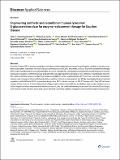Engineering synthetic and recombinant human lysosomal β-glucocerebrosidase for enzyme replacement therapy for Gaucher disease
Author(s)
Figueiredo, Lílian L. S.; Junior, Wilson L.; da Silva Goncalves, Victor W.; Ramos, Ester S.; D’Almeida, Vania; de Souza, Lucas E. B.; Orellana, Maristela D.; Abraham, Kuruvilla J.; Lichtenstein, Flávio; Bleicher, Lucas; ... Show more Show less
Download42452_2024_Article_6227.pdf (2.729Mb)
Publisher with Creative Commons License
Publisher with Creative Commons License
Creative Commons Attribution
Terms of use
Metadata
Show full item recordAbstract
Gaucher Disease (GD) is an autosomal recessive, lysosomal storage disease caused by pathogenic variants in the glucocerebrosidase gene, leading to the loss of β-glucocerebrosidase (GCase) enzymatic activity. Enzyme replacement therapy (ERT) with recombinant GCase is the standard of care in GD patients. Our study investigates the combined use of in silico molecular evolution, synthetic biology and gene therapy approaches to develop a new synthetic recombinant enzyme. We engineered four GCases containing missense mutations in the signal peptide (SP) from four selected mammalian species, and compared them with human GCase without missense mutations in the SP. We investigated transcriptional regulation with CMV and hEF1a promoters alongside a GFP control construct in 293-FT human cells. One hEF1a-driven mutant GCase shows a 5.2-fold higher level of transcription than control GCase. In addition, this mutant exhibits up to a sixfold higher activity compared with the mock-control, and the predicted tertiary structure of this mutant GCase aligns with human GCase. We also evaluated conserved and coevolved residues mapped to functionally important positions. Further studies are needed to assess its functionality in a GD animal model. Altogether, our findings provide in vitro evidence of the potential of this engineered enzyme for improved therapeutic effects for GD.
Date issued
2024-10-04Department
Massachusetts Institute of Technology. Synthetic Biology CenterJournal
Discover Applied Sciences
Publisher
Springer International Publishing
Citation
Figueiredo, L.L.S., Junior, W.L., da Silva Goncalves, V.W. et al. Engineering synthetic and recombinant human lysosomal β-glucocerebrosidase for enzyme replacement therapy for Gaucher disease. Discov Appl Sci 6, 527 (2024).
Version: Final published version